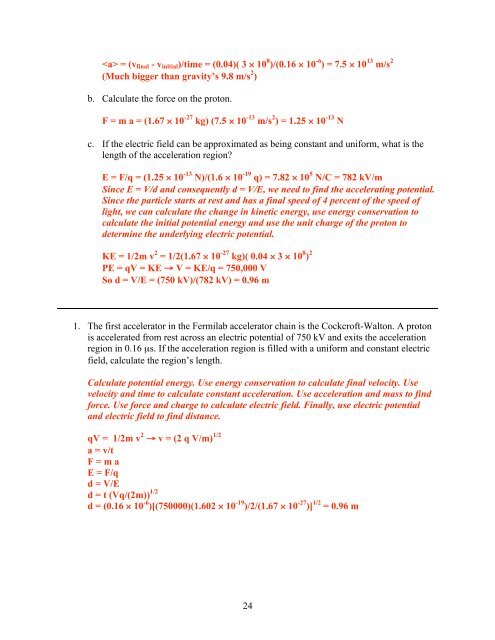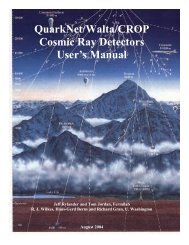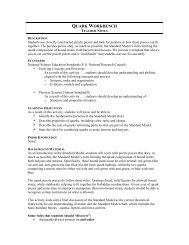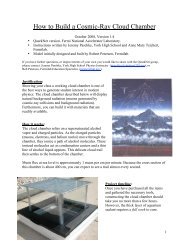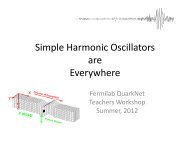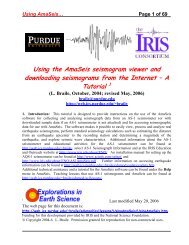Teaching Modern Physics - QuarkNet - Fermilab
Teaching Modern Physics - QuarkNet - Fermilab
Teaching Modern Physics - QuarkNet - Fermilab
Create successful ePaper yourself
Turn your PDF publications into a flip-book with our unique Google optimized e-Paper software.
= (vfinal - vinitial)/time = (0.04)( 3 × 10 8 )/(0.16 × 10 -6 ) = 7.5 × 10 13 m/s 2<br />
(Much bigger than gravity’s 9.8 m/s 2 )<br />
b. Calculate the force on the proton.<br />
F = m a = (1.67 × 10 -27 kg) (7.5 × 10 -13 m/s 2 ) = 1.25 × 10 -13 N<br />
c. If the electric field can be approximated as being constant and uniform, what is the<br />
length of the acceleration region?<br />
E = F/q = (1.25 × 10 -13 N)/(1.6 × 10 -19 q) = 7.82 × 10 5 N/C = 782 kV/m<br />
Since E = V/d and consequently d = V/E, we need to find the accelerating potential.<br />
Since the particle starts at rest and has a final speed of 4 percent of the speed of<br />
light, we can calculate the change in kinetic energy, use energy conservation to<br />
calculate the initial potential energy and use the unit charge of the proton to<br />
determine the underlying electric potential.<br />
KE = 1/2m v 2 = 1/2(1.67 × 10 -27 kg)( 0.04 × 3 × 10 8 ) 2<br />
PE = qV = KE → V = KE/q = 750,000 V<br />
So d = V/E = (750 kV)/(782 kV) = 0.96 m<br />
1. The first accelerator in the <strong>Fermilab</strong> accelerator chain is the Cockcroft-Walton. A proton<br />
is accelerated from rest across an electric potential of 750 kV and exits the acceleration<br />
region in 0.16 µs. If the acceleration region is filled with a uniform and constant electric<br />
field, calculate the region’s length.<br />
Calculate potential energy. Use energy conservation to calculate final velocity. Use<br />
velocity and time to calculate constant acceleration. Use acceleration and mass to find<br />
force. Use force and charge to calculate electric field. Finally, use electric potential<br />
and electric field to find distance.<br />
qV = 1/2m v 2 → v = (2 q V/m) 1/2<br />
a = v/t<br />
F = m a<br />
E = F/q<br />
d = V/E<br />
d = t (Vq/(2m)) 1/2<br />
d = (0.16 × 10 -6 )[(750000)(1.602 × 10 -19 )/2/(1.67 × 10 -27 )] 1/2 = 0.96 m<br />
24


